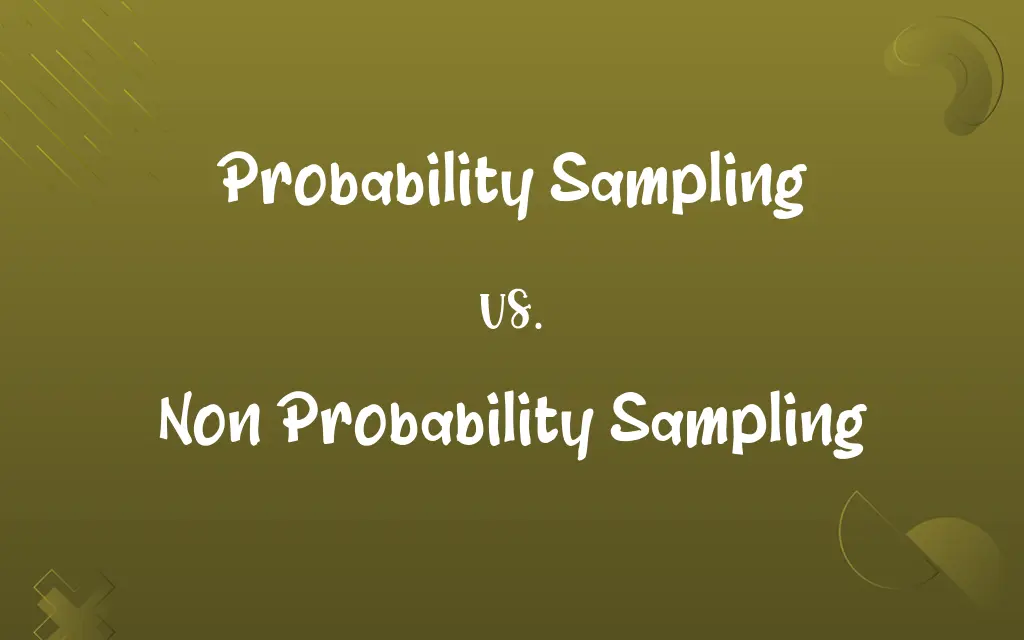Probability Sampling vs. Non Probability Sampling: Know the Difference

By Shumaila Saeed || Updated on December 25, 2023
Probability sampling involves random selection, ensuring each member of the population has a known chance of being selected. Non-probability sampling lacks this random selection, making it impossible to assess the probability of each member being chosen.

Key Differences
Probability sampling uses random selection methods, ensuring each member of the population has an equal and known chance of being selected. In contrast, non-probability sampling does not use random selection, and not every member has a chance of being included.
Shumaila Saeed
Nov 16, 2023
Probability sampling aims to be representative of the population, minimizing bias and allowing for generalization of results. Non-probability sampling often results in a less representative sample and can introduce bias, limiting the generalizability of the findings.
Shumaila Saeed
Nov 16, 2023
Common methods of probability sampling include simple random sampling, stratified sampling, and cluster sampling. Non-probability sampling includes convenience sampling, judgmental sampling, and quota sampling.
Shumaila Saeed
Nov 16, 2023
Probability sampling allows for precise estimation of sampling error and supports statistical inference. Non-probability sampling does not allow for estimation of sampling error, making statistical inferences less reliable.
Shumaila Saeed
Nov 16, 2023
Probability sampling is ideal for quantitative studies requiring generalizable results. Non-probability sampling is often used in qualitative research, exploratory studies, or when the population is not well-defined or accessible.
Shumaila Saeed
Nov 16, 2023
ADVERTISEMENT
Comparison Chart
Bias and Representativeness
Low bias, highly representative
Higher potential for bias, less representative
Shumaila Saeed
Nov 16, 2023
Common Methods
Simple random, stratified, cluster sampling
Convenience, judgmental, quota sampling
Shumaila Saeed
Nov 16, 2023
Statistical Inference
Allows precise error estimation, supports inference
Does not support reliable statistical inferences
Shumaila Saeed
Nov 16, 2023
Typical Use
Quantitative studies, generalizable research
Qualitative research, exploratory studies
Shumaila Saeed
Nov 16, 2023
ADVERTISEMENT
Probability Sampling and Non Probability Sampling Definitions
Probability Sampling
Probability sampling ensures every individual in the population has an equal chance of being selected.
We used probability sampling to ensure our survey results could be generalized to the entire population.
Shumaila Saeed
Nov 10, 2023
Non Probability Sampling
A non-probability sampling technique where existing study subjects recruit future subjects.
In our study on rare diseases, we used snowball non-probability sampling to reach more participants.
Shumaila Saeed
Nov 10, 2023
Probability Sampling
The most basic form of probability sampling, where each member has an equal chance of being chosen.
We used simple random probability sampling to select participants for the clinical trial.
Shumaila Saeed
Nov 10, 2023
Non Probability Sampling
Selecting individuals for non-probability sampling based on specific purposes or qualities.
Our study on professional athletes utilized purposive non-probability sampling to target a specific group.
Shumaila Saeed
Nov 10, 2023
Probability Sampling
Probability sampling involving dividing the population into clusters and randomly selecting entire clusters.
Due to logistical constraints, we opted for cluster probability sampling for our nationwide survey.
Shumaila Saeed
Nov 10, 2023
ADVERTISEMENT
Non Probability Sampling
Non-probability sampling where the researcher fills a quota for certain characteristics or groups.
We implemented quota non-probability sampling to ensure a balance of gender and age in our survey.
Shumaila Saeed
Nov 10, 2023
Probability Sampling
Probability sampling aims to create a sample representative of the entire population.
In our research, we employed probability sampling to accurately reflect the diverse opinions of the community.
Shumaila Saeed
Nov 10, 2023
Non Probability Sampling
Selection based on the researcher's judgment in non-probability sampling.
For our specialized study, we relied on judgmental non-probability sampling to choose experts in the field.
Shumaila Saeed
Nov 10, 2023
Probability Sampling
A form of probability sampling where the population is divided into strata, and random samples are taken from each stratum.
Stratified probability sampling was used to ensure representation from all age groups in the study.
Shumaila Saeed
Nov 10, 2023
Non Probability Sampling
Non-probability sampling where participants are selected based on availability and convenience.
We used convenience non-probability sampling by surveying students in the campus cafeteria.
Shumaila Saeed
Nov 10, 2023
Repeatedly Asked Queries
What defines probability sampling?
Probability sampling is defined by its use of random selection, giving each population member a known chance of being chosen.
Shumaila Saeed
Nov 16, 2023
What is a key advantage of probability sampling?
A key advantage is its representativeness, allowing for generalization of results to the larger population.
Shumaila Saeed
Nov 16, 2023
How does sample size impact probability sampling?
Larger sample sizes in probability sampling lead to more accurate and reliable results.
Shumaila Saeed
Nov 16, 2023
Is non-probability sampling faster and less expensive?
Yes, it is often quicker and more cost-effective compared to probability sampling.
Shumaila Saeed
Nov 16, 2023
Is probability sampling suitable for qualitative research?
Probability sampling is less commonly used in qualitative research, which often requires specific types of participants.
Shumaila Saeed
Nov 16, 2023
When is non-probability sampling used?
It's often used in qualitative research, exploratory studies, or when the population is hard to access.
Shumaila Saeed
Nov 16, 2023
Can non-probability sampling be generalized to the entire population?
Due to potential biases, generalization to the entire population is limited with non-probability sampling.
Shumaila Saeed
Nov 16, 2023
What are common methods of non-probability sampling?
Common methods include convenience, judgmental, quota, and snowball sampling.
Shumaila Saeed
Nov 16, 2023
Can probability sampling eliminate sampling bias?
Probability sampling greatly reduces sampling bias but cannot eliminate it entirely.
Shumaila Saeed
Nov 16, 2023
What is non-probability sampling?
Non-probability sampling involves selecting samples without using random selection methods.
Shumaila Saeed
Nov 16, 2023
Can probability sampling be used in all types of research?
While versatile, it may not be suitable for all research types, especially those requiring specific participant traits.
Shumaila Saeed
Nov 16, 2023
Can non-probability samples be statistically analyzed?
They can be analyzed, but statistical inferences to the wider population are limited.
Shumaila Saeed
Nov 16, 2023
What are the disadvantages of probability sampling?
Disadvantages include higher cost, more time consumption, and the need for a complete population list.
Shumaila Saeed
Nov 16, 2023
Is non-probability sampling less scientific than probability sampling?
It's not less scientific but is suited to different research goals and methodologies.
Shumaila Saeed
Nov 16, 2023
How do researchers decide between probability and non-probability sampling?
The decision is based on research goals, available resources, and the nature of the study population.
Shumaila Saeed
Nov 16, 2023
Are there ethical considerations in probability sampling?
Yes, ethical considerations include ensuring confidentiality and obtaining informed consent.
Shumaila Saeed
Nov 16, 2023
How does the choice of sampling method affect research credibility?
The choice impacts credibility, with probability sampling often seen as more rigorous and reliable for generalizing findings.
Shumaila Saeed
Nov 16, 2023
How does purposive sampling differ in non-probability sampling?
Purposive sampling selects individuals based on specific characteristics or research goals.
Shumaila Saeed
Nov 16, 2023
How does random selection impact the validity of probability sampling?
Random selection increases the validity of the results by reducing bias.
Shumaila Saeed
Nov 16, 2023
What role does researcher bias play in non-probability sampling?
Researcher bias can be more pronounced in non-probability sampling due to the subjective nature of sample selection.
Shumaila Saeed
Nov 16, 2023
Share this page
Link for your blog / website
HTML
Link to share via messenger
About Author
Written by
Shumaila SaeedShumaila Saeed, an expert content creator with 6 years of experience, specializes in distilling complex topics into easily digestible comparisons, shining a light on the nuances that both inform and educate readers with clarity and accuracy.








































































